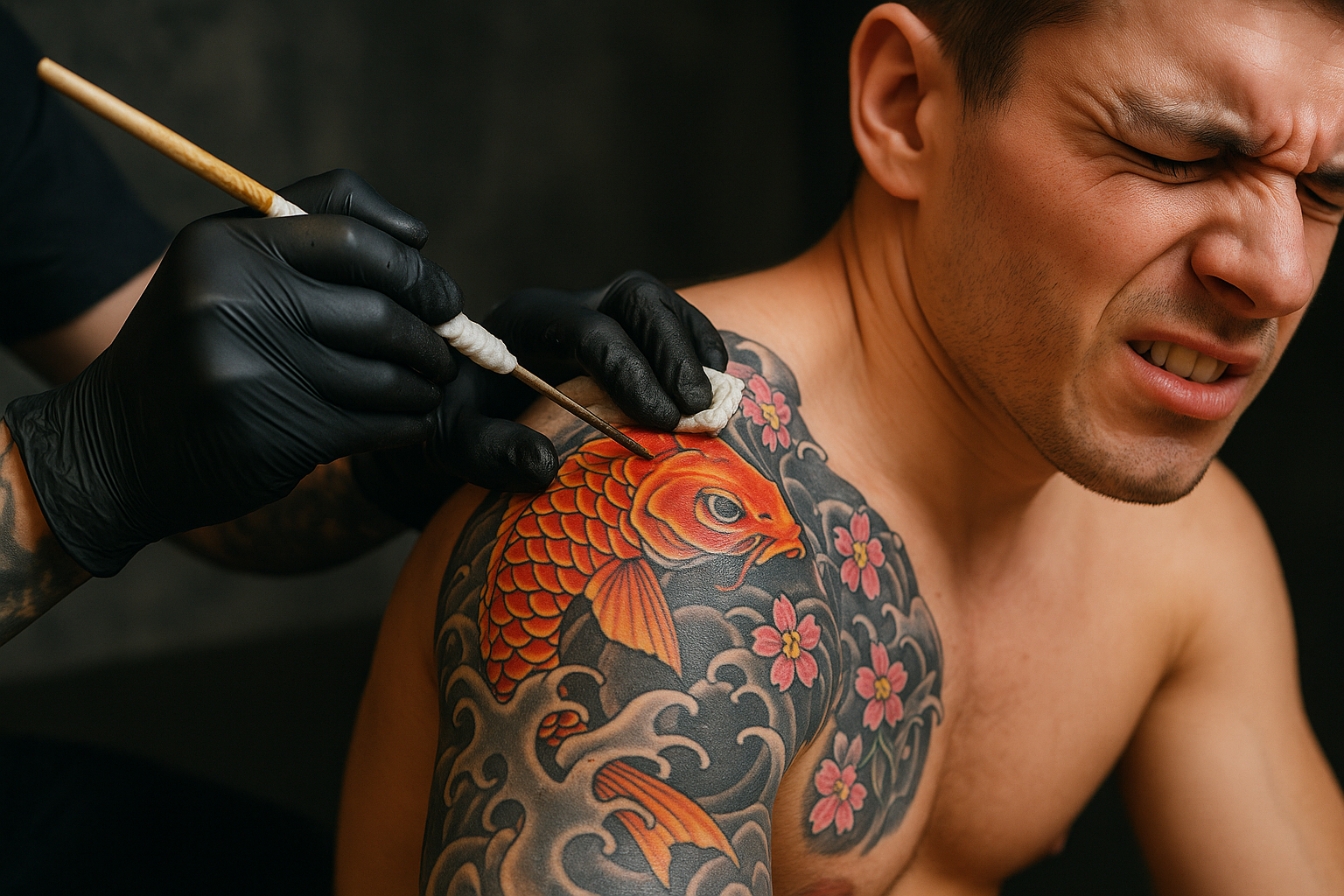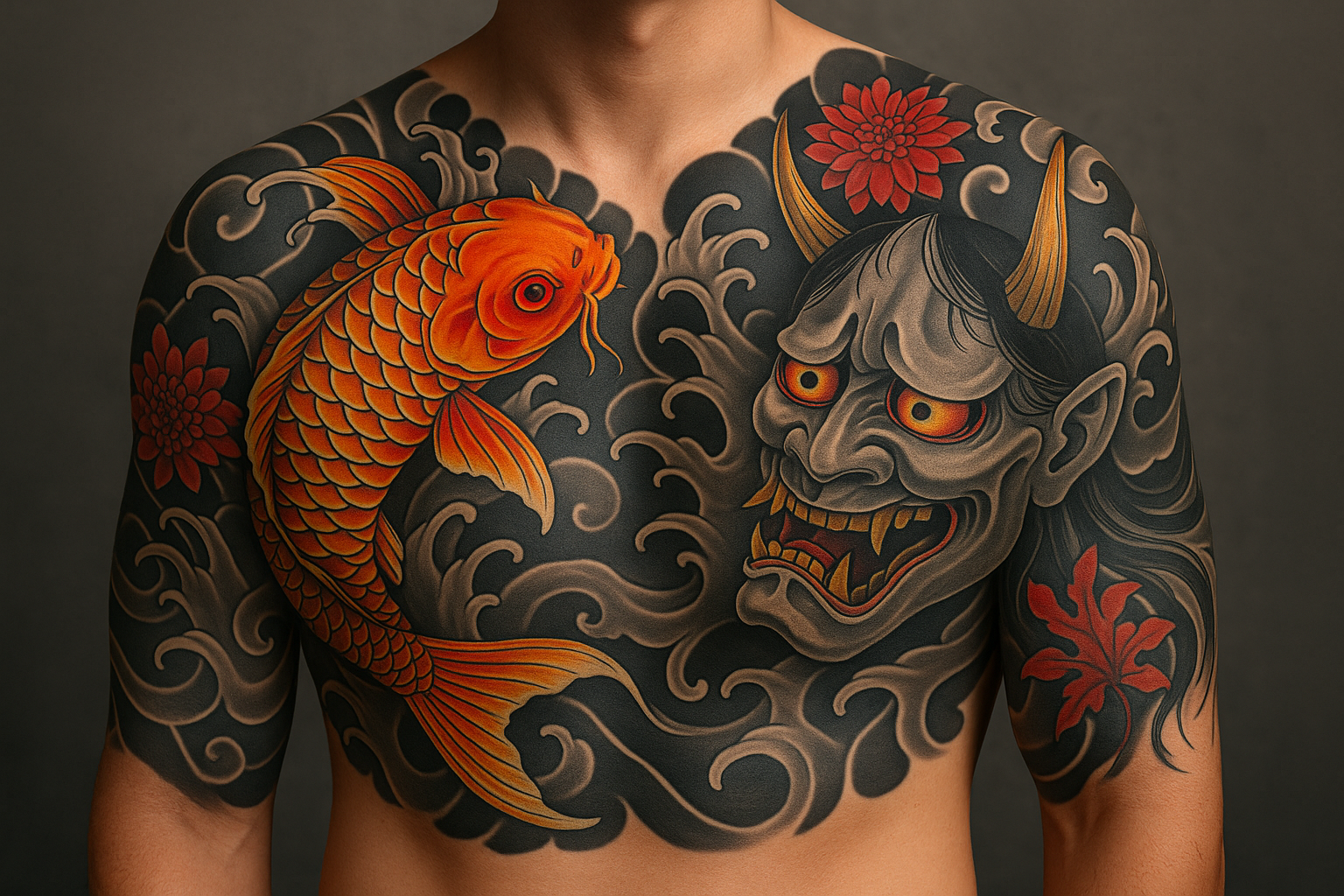Irezumi Tattoo Meanings Decoded: How to Choose the Right Symbol for Your Story
Irezumi—the art of traditional Japanese tattooing—is not just about bold lines and flowing forms. It’s a system of symbolic storytelling. Every koi, dragon, or cherry blossom inked on the skin holds weight. And if you’re considering one, especially as someone outside Japanese culture, the question isn’t just “What looks cool?” It’s:
“What does this tattoo say about me—and is it the right story to wear forever?”
In this guide, we’ll decode the most common irezumi symbols and help you choose one that aligns with your personal narrative while respecting the culture it comes from.
🔍 Why the Meaning Behind Irezumi Matters
Before diving into specific motifs, it’s essential to understand the why. Unlike flash tattoos or Pinterest trends, irezumi designs:
- Are deeply connected to Japanese folklore, Buddhism, and Shinto spirituality
- Represent specific values, struggles, and archetypes
- Are often chosen as life companions, not just body decorations
This means the symbol you wear speaks to the world—not just about your aesthetics, but your inner world, too.
So if you’re about to get inked with a piece of living Japanese heritage, you owe it to yourself—and the tradition—to get it right.
🧭 Step One: What Kind of Story Do You Want to Tell?
Your tattoo should reflect something true about you. Here are a few story types that irezumi can symbolize:
- Overcoming struggle
- Seeking transformation
- Embodying spiritual protection
- Remembering a loved one
- Wielding power with restraint
- Embracing impermanence
Once you define your core message, you can begin decoding which symbols align with that energy.
Let’s break them down.
🐟 Koi Fish – For the Resilient Climber
Meaning: Determination, transformation, resilience against hardship.
In Japanese legend, koi swim upstream against powerful currents. If they survive the climb and leap over the Dragon Gate, they transform into dragons. This is the ultimate underdog story.
- Upstream koi: You’re still fighting the current
- Downstream koi: You’ve accepted your fate or found peace
- Golden koi: Wealth and luck
- Black koi: Masculine energy, overcoming struggle
Perfect for: Someone who has overcome addiction, loss, poverty—or is still in the climb.
🐉 Dragons – For the Powerful Protector
Meaning: Power, wisdom, protection, divine balance.
Unlike Western dragons (often symbols of greed or destruction), Japanese dragons are wise, water-based, and benevolent. They symbolize protection of what’s sacred, especially against unseen forces.
- Blue dragon: Peaceful and observant
- Red dragon: Passion and strength
- Black dragon: Wisdom and age
- Gold dragon: Power tempered by virtue
Perfect for: Leaders, protectors, or those who’ve learned to balance power with compassion.
😈 Oni and Hannya – For the Shadow Warrior
Meaning: Anger, jealousy, pain, and their transformation into spiritual insight.
Oni are ogre-like demons, and Hannya masks represent a woman driven mad by betrayal and grief. But these aren’t just evil figures—they embody emotions turned monstrous. When placed properly, they serve as reminders of what we’ve overcome—or warnings of the darkness within.
- Hannya with eyes up: You’ve overcome your pain
- Hannya with eyes down: You still carry resentment
- Oni with flowers: You’ve made peace with your rage
Perfect for: People who’ve lived through betrayal, abuse, or self-destruction—and came back stronger.
🌸 Cherry Blossoms – For the Philosopher of Impermanence
Meaning: Beauty, ephemerality, life’s fleeting nature.
In Japanese culture, cherry blossoms fall at their most beautiful—reminding us that everything, even life, is temporary. It’s the central tenet of Bushido (the samurai code), where warriors must live fully, knowing they may die tomorrow.
- Often paired with skulls, waves, or animals
- Usually used to balance darker motifs
Perfect for: Those who’ve experienced loss, or embrace life deeply because they know it’s short.
🐅 Tigers – For the Fierce and Independent
Meaning: Strength, protection, courage.
Tigers in Japanese tattooing are not just apex predators—they’re guardians of sacred lands. They’re often used to ward off evil spirits and represent fierce independence.
- Right-facing tiger: outward aggression
- Left-facing tiger: inner strength
- Often paired with bamboo, waves, or wind
Perfect for: Someone who protects others, fights back, or lives by instinct.
🐍 Snakes – For the Transformer and Healer
Meaning: Protection, rebirth, wisdom.
In Japanese lore, snakes are both feared and revered. They shed their skin to transform, symbolizing renewal, but also protect from misfortune and illness. Sometimes associated with female deities or fox spirits.
- White snake: divine, pure
- Coiled snake: guarded but potent
- Snake with skulls: survival through danger
Perfect for: Survivors, healers, or people entering a new phase of life.
🔥 Fudo Myoo – For the Disciplined and Devoted
Meaning: Immovable wisdom, inner fire, spiritual strength.
Fudo Myoo is a wrathful Buddhist deity who burns away ignorance and protects seekers of truth. His face is furious, sword in one hand, rope in the other—cutting through illusions and binding evil.
- Surrounded by flames
- Usually back or shoulder placement
- One of the most sacred irezumi motifs
Perfect for: Spiritual warriors, truth-seekers, or those committed to purpose through chaos.
🌀 Windbars and Waves – For the Flow-Conscious
Meaning: Life’s unpredictability, change, flow, and force.
These are not standalone tattoos but background elements that set the emotional tone.
- Windbars (kamikaze): sudden change, invisible influence
- Waves (nami): cleansing, destruction, emotional power
They can amplify or contrast with the foreground motif, so choose carefully.
Perfect for: Anyone who respects nature’s power or has ridden many emotional highs and lows.
🐦 Phoenix – For the Reborn
Meaning: Renewal, grace, fire-transformed identity.
Though more Chinese than Japanese, the phoenix (or Hō-ō) appears in some irezumi as a symbol of rising from destruction. The bird is consumed in flames and resurrected anew.
- Usually colorful: reds, golds, oranges
- Often paired with floral motifs
Perfect for: Those who’ve rebuilt their lives after loss, illness, or identity collapse.
⚠️ Don’t Just Pick What “Looks Cool”
Here’s the trap many people fall into: copying a tattoo without understanding its meaning.
If you choose based on aesthetics alone:
- You may wear conflicting symbols (e.g., koi + oni = courage + chaos)
- You might send the wrong signal (e.g., hannya mask = unresolved rage)
- You could disrespect sacred figures (e.g., Buddha near the ankle)
Instead, start with your story. Then match the symbol to what you’ve lived, what you stand for, or what you want to become.
🧠 4 Questions to Help You Choose the Right Irezumi Symbol
- What major emotional or life battle have I overcome?
- (Loss? Rage? Addiction? Displacement? Powerlessness?)
- What values define me at my best?
- (Discipline? Rebirth? Loyalty? Inner fire?)
- What do I want to become more of?
- (Wiser? More powerful? More compassionate?)
- Do I respect the cultural context this symbol comes from?
- (Would I be okay explaining it to someone Japanese?)
Your answers will narrow your options quickly—and meaningfully.
🙏 How to Honor the Culture While Wearing Its Symbols
Choosing the right irezumi symbol also means honoring where it comes from:
- Study the stories behind the symbols—not just summaries, but full mythologies.
- Use proper placement: some designs belong on the back, others on the arm.
- Work with a tattoo artist who respects irezumi—not just imitates it.
- Avoid sacred figures below the waist (like Buddha or Fudo Myoo)
- Don’t mash symbols from multiple cultures into one (e.g., koi + Aztec eagle + Norse runes)
This shows that your tattoo isn’t borrowed—it’s understood.
🏆 Final Tip: Let the Artist Help You Tell It Right
Even if you have the perfect symbol in mind, the execution matters. That’s where your artist comes in.
A skilled irezumi-style artist will:
- Help you pick the right size, flow, and background
- Guide you on traditional composition rules
- Ensure that elements don’t clash (symbolically or visually)
This way, your tattoo tells a coherent story—not a collage of chaos.
🎯 Conclusion: Your Ink, Your Legacy
Irezumi is not about decoration. It’s about declaration.
When you wear a koi, you’re not just wearing a fish—you’re saying: “I keep going, even when the river tries to drown me.”
When you wear a Hannya, you’re not just wearing a mask—you’re saying: “I’ve known grief so deep it turned me into someone else—and I survived.”
Your skin becomes your scripture.
So choose your irezumi like you’d choose a truth you’re ready to carry forever. Because when the meaning fits your story, it doesn’t just sit on your skin.
It speaks from it.


